Research Evaluation: Lifestyle Intervention by Community Nurses Trial
VerifiedAdded on 2023/01/16
|7
|1742
|41
Report
AI Summary
This report provides an evaluation of a research article focusing on lifestyle interventions delivered by generalist community nurses, specifically the CN SNAP trial. The evaluation encompasses the research design, methods, procedures, and study results, with a discussion on its contribution to evidence-based practice. The study, conducted within four community nursing services in New South Wales, Australia, employed a quasi-experimental design, assigning services to either an early intervention (EI) or late intervention (LI) group. The research involved quantitative data collection through telephone surveys and examined the impact of brief smoking, nutrition, alcohol, activity, and overweight (SNAPW) interventions. The report concludes that while the intervention showed promise, more intensive and effective interventions are needed, highlighting challenges and opportunities for community healthcare facilities in promoting lifestyle changes.
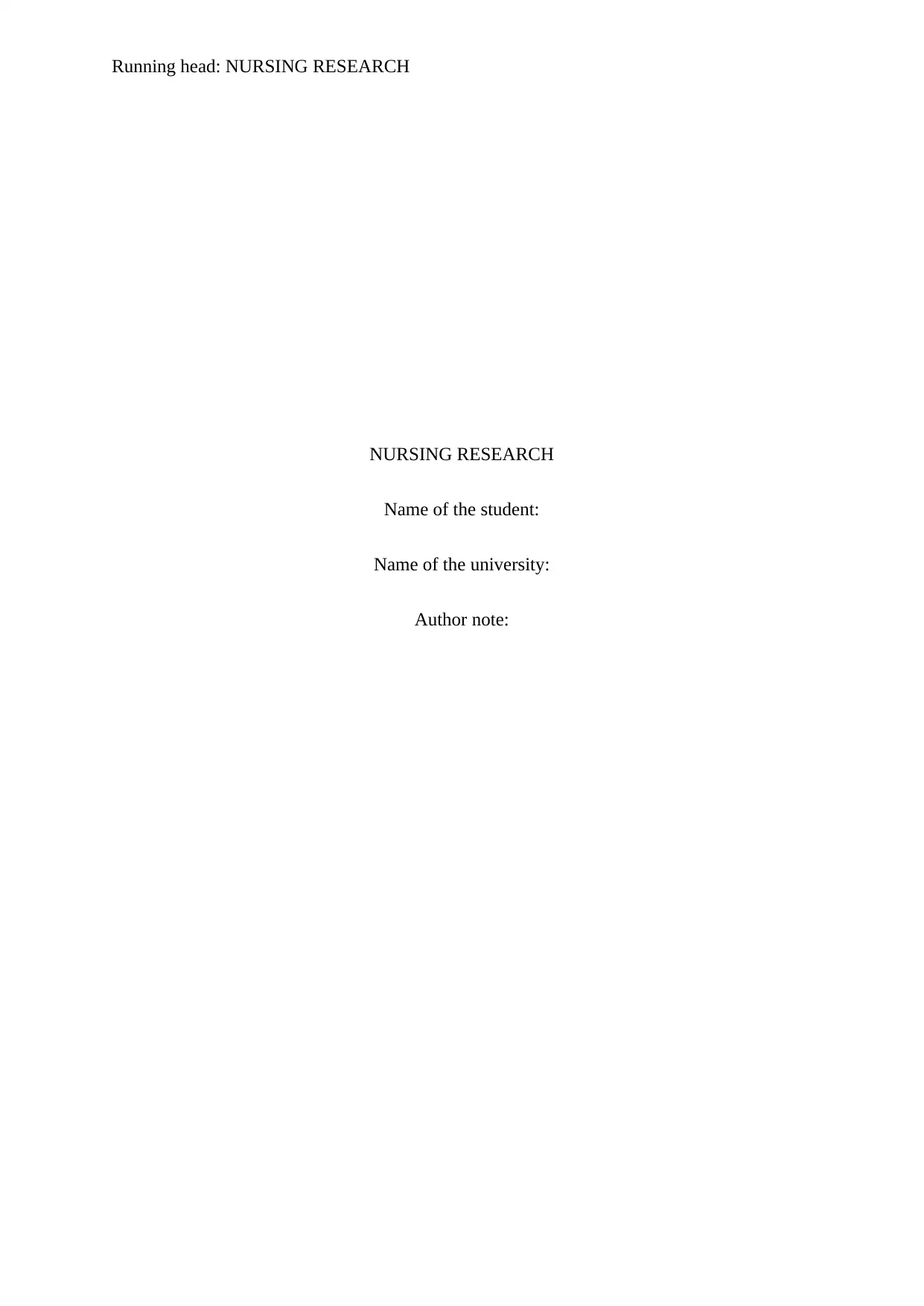
Running head: NURSING RESEARCH
NURSING RESEARCH
Name of the student:
Name of the university:
Author note:
NURSING RESEARCH
Name of the student:
Name of the university:
Author note:
Paraphrase This Document
Need a fresh take? Get an instant paraphrase of this document with our AI Paraphraser
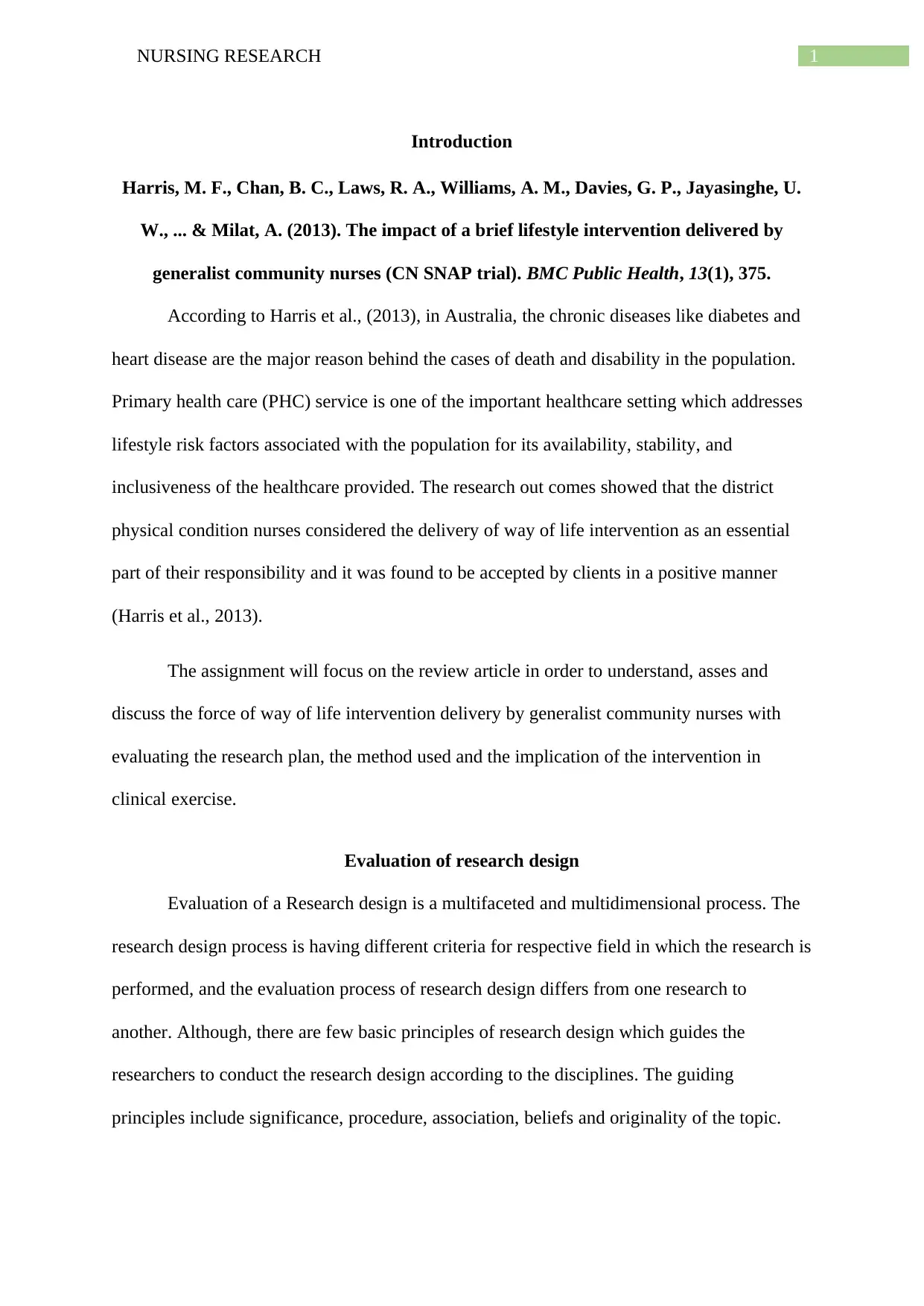
1NURSING RESEARCH
Introduction
Harris, M. F., Chan, B. C., Laws, R. A., Williams, A. M., Davies, G. P., Jayasinghe, U.
W., ... & Milat, A. (2013). The impact of a brief lifestyle intervention delivered by
generalist community nurses (CN SNAP trial). BMC Public Health, 13(1), 375.
According to Harris et al., (2013), in Australia, the chronic diseases like diabetes and
heart disease are the major reason behind the cases of death and disability in the population.
Primary health care (PHC) service is one of the important healthcare setting which addresses
lifestyle risk factors associated with the population for its availability, stability, and
inclusiveness of the healthcare provided. The research out comes showed that the district
physical condition nurses considered the delivery of way of life intervention as an essential
part of their responsibility and it was found to be accepted by clients in a positive manner
(Harris et al., 2013).
The assignment will focus on the review article in order to understand, asses and
discuss the force of way of life intervention delivery by generalist community nurses with
evaluating the research plan, the method used and the implication of the intervention in
clinical exercise.
Evaluation of research design
Evaluation of a Research design is a multifaceted and multidimensional process. The
research design process is having different criteria for respective field in which the research is
performed, and the evaluation process of research design differs from one research to
another. Although, there are few basic principles of research design which guides the
researchers to conduct the research design according to the disciplines. The guiding
principles include significance, procedure, association, beliefs and originality of the topic.
Introduction
Harris, M. F., Chan, B. C., Laws, R. A., Williams, A. M., Davies, G. P., Jayasinghe, U.
W., ... & Milat, A. (2013). The impact of a brief lifestyle intervention delivered by
generalist community nurses (CN SNAP trial). BMC Public Health, 13(1), 375.
According to Harris et al., (2013), in Australia, the chronic diseases like diabetes and
heart disease are the major reason behind the cases of death and disability in the population.
Primary health care (PHC) service is one of the important healthcare setting which addresses
lifestyle risk factors associated with the population for its availability, stability, and
inclusiveness of the healthcare provided. The research out comes showed that the district
physical condition nurses considered the delivery of way of life intervention as an essential
part of their responsibility and it was found to be accepted by clients in a positive manner
(Harris et al., 2013).
The assignment will focus on the review article in order to understand, asses and
discuss the force of way of life intervention delivery by generalist community nurses with
evaluating the research plan, the method used and the implication of the intervention in
clinical exercise.
Evaluation of research design
Evaluation of a Research design is a multifaceted and multidimensional process. The
research design process is having different criteria for respective field in which the research is
performed, and the evaluation process of research design differs from one research to
another. Although, there are few basic principles of research design which guides the
researchers to conduct the research design according to the disciplines. The guiding
principles include significance, procedure, association, beliefs and originality of the topic.

2NURSING RESEARCH
These standards help the researcher to perform the study in an organized manner(Harris et al.,
2013).
In the article, the learning was directed within four common community nursing
services in the New South Wales of Australia. These four forces were enlisted by circulation
of concern mailed to every Area Health Services (AHS) in the region of New South Wales
using Pest Analysis (n = 8). The research plan was a quasi-experimental process, where the
services were aimlessly assigned to a group of ‘early intervention’ (EI) or a group of ‘late
intervention’ (LI) which was used for comparison (Harris et al., 2013). Early Intervention
forces were accommodated with teaching facilities and maintain system for the nurses in
classifying patients with the high-risk and contributing brief smoking, nourishment, alcohol
and activity and overweight (SNAPW) interference during their habit discussions. One nurse
from individual early intervention group was backed in order to work with the researcher to
develop the healthcare interventions and to implicate them to the local population. The nurses
first studied the risk factors of the population and then implemented educational intervention
to them and developed a mind-set in them to adapt according to change, for the SNAPW risk
factors. This took about two to three visiting. People who were more susceptible to the
danger factors were referred for further concentrated intervention (Harris et al., 2013).
The ethical considerations in the study was maintained by authorizing it by the
University of New South Wales Human Research Ethics Committee (HREC) and also
approving the project from Hunter New England Human Research Ethics Committee and the
Human Research Ethics Committees in every participating Area Health Services. The study
was performed by obeying the rules and policies of these Committees and the Helsinki
statement. All the participants gave a written consent on publishing the article (De Smit et al.,
2016).
These standards help the researcher to perform the study in an organized manner(Harris et al.,
2013).
In the article, the learning was directed within four common community nursing
services in the New South Wales of Australia. These four forces were enlisted by circulation
of concern mailed to every Area Health Services (AHS) in the region of New South Wales
using Pest Analysis (n = 8). The research plan was a quasi-experimental process, where the
services were aimlessly assigned to a group of ‘early intervention’ (EI) or a group of ‘late
intervention’ (LI) which was used for comparison (Harris et al., 2013). Early Intervention
forces were accommodated with teaching facilities and maintain system for the nurses in
classifying patients with the high-risk and contributing brief smoking, nourishment, alcohol
and activity and overweight (SNAPW) interference during their habit discussions. One nurse
from individual early intervention group was backed in order to work with the researcher to
develop the healthcare interventions and to implicate them to the local population. The nurses
first studied the risk factors of the population and then implemented educational intervention
to them and developed a mind-set in them to adapt according to change, for the SNAPW risk
factors. This took about two to three visiting. People who were more susceptible to the
danger factors were referred for further concentrated intervention (Harris et al., 2013).
The ethical considerations in the study was maintained by authorizing it by the
University of New South Wales Human Research Ethics Committee (HREC) and also
approving the project from Hunter New England Human Research Ethics Committee and the
Human Research Ethics Committees in every participating Area Health Services. The study
was performed by obeying the rules and policies of these Committees and the Helsinki
statement. All the participants gave a written consent on publishing the article (De Smit et al.,
2016).
⊘ This is a preview!⊘
Do you want full access?
Subscribe today to unlock all pages.

Trusted by 1+ million students worldwide
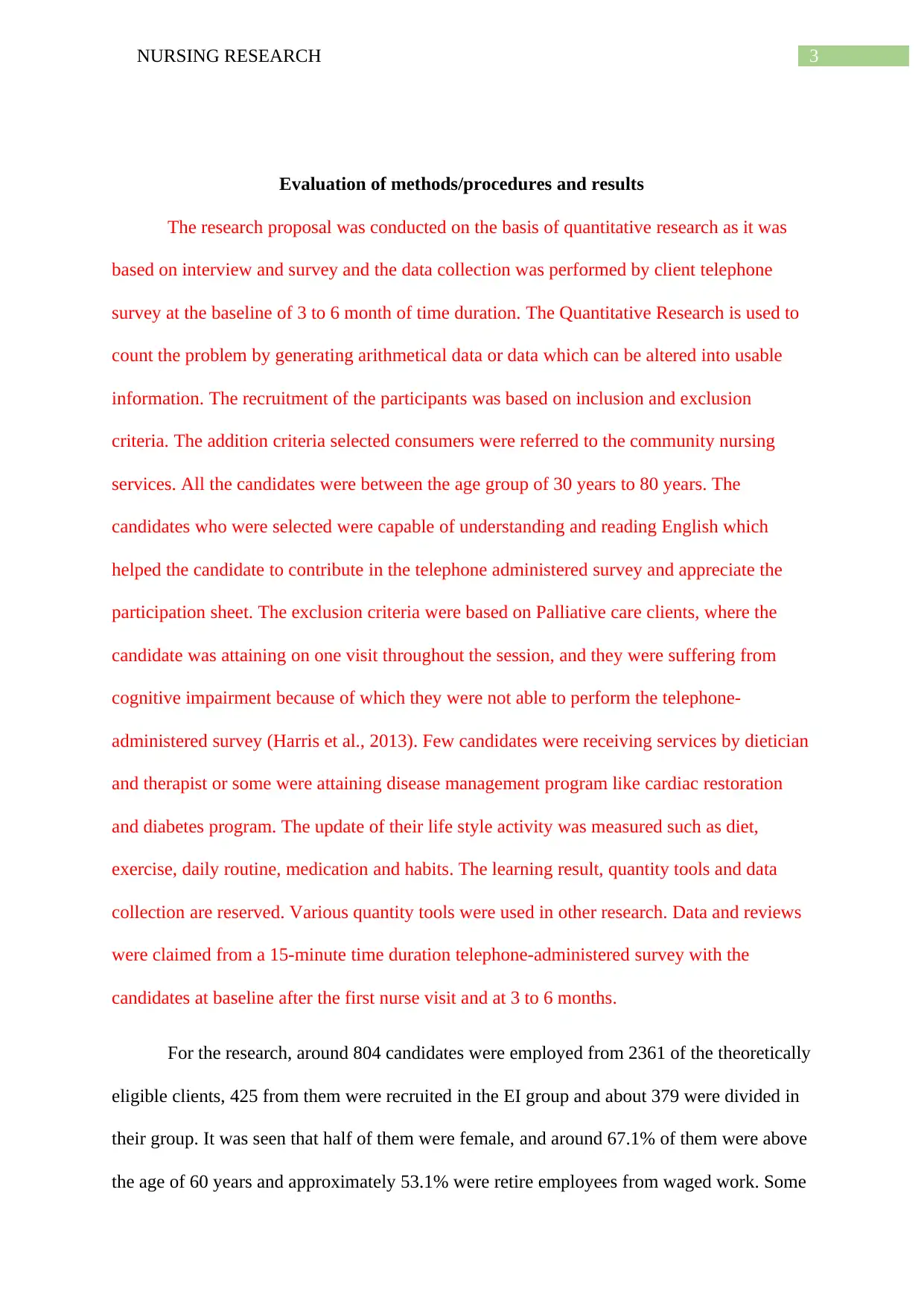
3NURSING RESEARCH
Evaluation of methods/procedures and results
The research proposal was conducted on the basis of quantitative research as it was
based on interview and survey and the data collection was performed by client telephone
survey at the baseline of 3 to 6 month of time duration. The Quantitative Research is used to
count the problem by generating arithmetical data or data which can be altered into usable
information. The recruitment of the participants was based on inclusion and exclusion
criteria. The addition criteria selected consumers were referred to the community nursing
services. All the candidates were between the age group of 30 years to 80 years. The
candidates who were selected were capable of understanding and reading English which
helped the candidate to contribute in the telephone administered survey and appreciate the
participation sheet. The exclusion criteria were based on Palliative care clients, where the
candidate was attaining on one visit throughout the session, and they were suffering from
cognitive impairment because of which they were not able to perform the telephone-
administered survey (Harris et al., 2013). Few candidates were receiving services by dietician
and therapist or some were attaining disease management program like cardiac restoration
and diabetes program. The update of their life style activity was measured such as diet,
exercise, daily routine, medication and habits. The learning result, quantity tools and data
collection are reserved. Various quantity tools were used in other research. Data and reviews
were claimed from a 15-minute time duration telephone-administered survey with the
candidates at baseline after the first nurse visit and at 3 to 6 months.
For the research, around 804 candidates were employed from 2361 of the theoretically
eligible clients, 425 from them were recruited in the EI group and about 379 were divided in
their group. It was seen that half of them were female, and around 67.1% of them were above
the age of 60 years and approximately 53.1% were retire employees from waged work. Some
Evaluation of methods/procedures and results
The research proposal was conducted on the basis of quantitative research as it was
based on interview and survey and the data collection was performed by client telephone
survey at the baseline of 3 to 6 month of time duration. The Quantitative Research is used to
count the problem by generating arithmetical data or data which can be altered into usable
information. The recruitment of the participants was based on inclusion and exclusion
criteria. The addition criteria selected consumers were referred to the community nursing
services. All the candidates were between the age group of 30 years to 80 years. The
candidates who were selected were capable of understanding and reading English which
helped the candidate to contribute in the telephone administered survey and appreciate the
participation sheet. The exclusion criteria were based on Palliative care clients, where the
candidate was attaining on one visit throughout the session, and they were suffering from
cognitive impairment because of which they were not able to perform the telephone-
administered survey (Harris et al., 2013). Few candidates were receiving services by dietician
and therapist or some were attaining disease management program like cardiac restoration
and diabetes program. The update of their life style activity was measured such as diet,
exercise, daily routine, medication and habits. The learning result, quantity tools and data
collection are reserved. Various quantity tools were used in other research. Data and reviews
were claimed from a 15-minute time duration telephone-administered survey with the
candidates at baseline after the first nurse visit and at 3 to 6 months.
For the research, around 804 candidates were employed from 2361 of the theoretically
eligible clients, 425 from them were recruited in the EI group and about 379 were divided in
their group. It was seen that half of them were female, and around 67.1% of them were above
the age of 60 years and approximately 53.1% were retire employees from waged work. Some
Paraphrase This Document
Need a fresh take? Get an instant paraphrase of this document with our AI Paraphraser
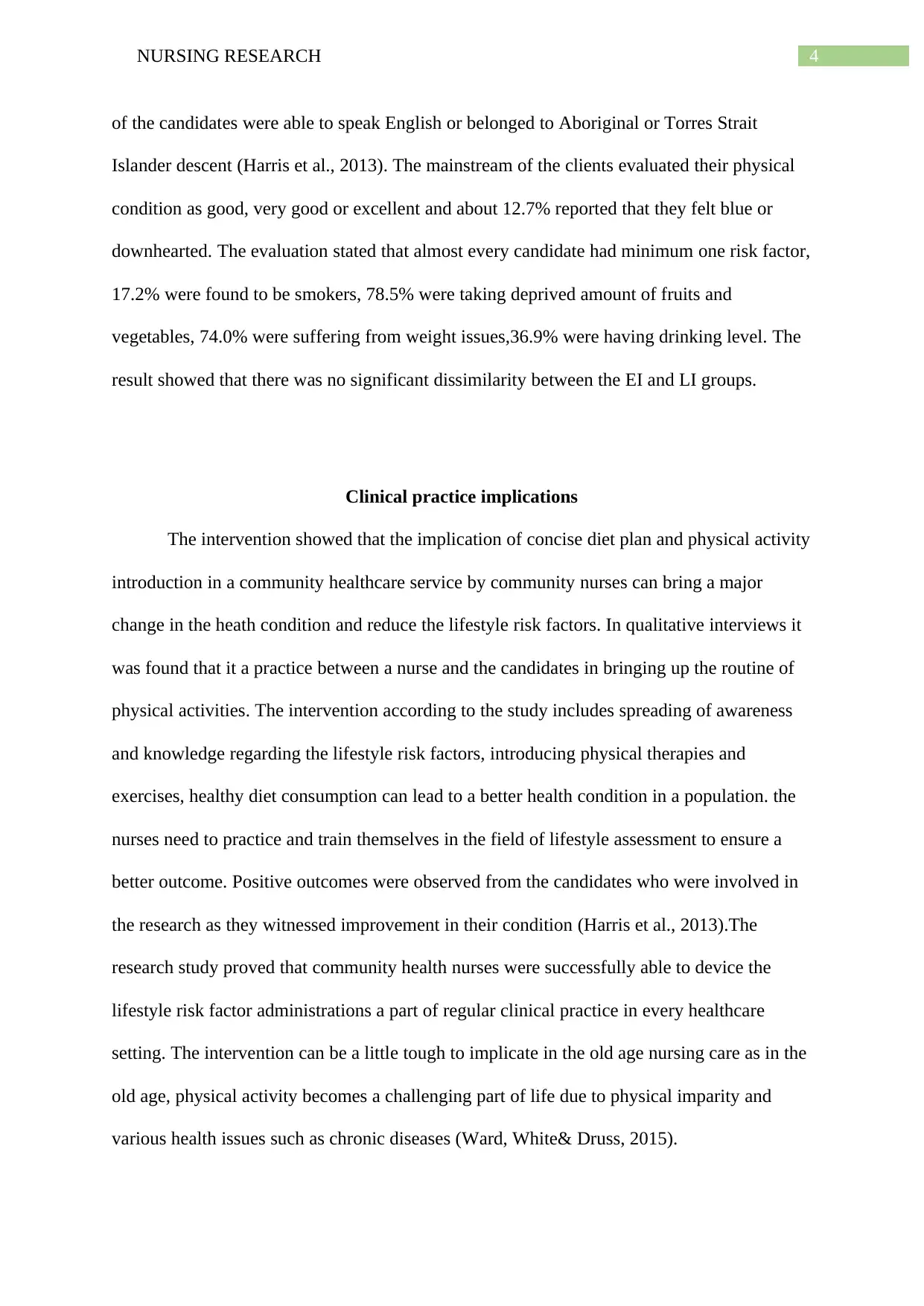
4NURSING RESEARCH
of the candidates were able to speak English or belonged to Aboriginal or Torres Strait
Islander descent (Harris et al., 2013). The mainstream of the clients evaluated their physical
condition as good, very good or excellent and about 12.7% reported that they felt blue or
downhearted. The evaluation stated that almost every candidate had minimum one risk factor,
17.2% were found to be smokers, 78.5% were taking deprived amount of fruits and
vegetables, 74.0% were suffering from weight issues,36.9% were having drinking level. The
result showed that there was no significant dissimilarity between the EI and LI groups.
Clinical practice implications
The intervention showed that the implication of concise diet plan and physical activity
introduction in a community healthcare service by community nurses can bring a major
change in the heath condition and reduce the lifestyle risk factors. In qualitative interviews it
was found that it a practice between a nurse and the candidates in bringing up the routine of
physical activities. The intervention according to the study includes spreading of awareness
and knowledge regarding the lifestyle risk factors, introducing physical therapies and
exercises, healthy diet consumption can lead to a better health condition in a population. the
nurses need to practice and train themselves in the field of lifestyle assessment to ensure a
better outcome. Positive outcomes were observed from the candidates who were involved in
the research as they witnessed improvement in their condition (Harris et al., 2013).The
research study proved that community health nurses were successfully able to device the
lifestyle risk factor administrations a part of regular clinical practice in every healthcare
setting. The intervention can be a little tough to implicate in the old age nursing care as in the
old age, physical activity becomes a challenging part of life due to physical imparity and
various health issues such as chronic diseases (Ward, White& Druss, 2015).
of the candidates were able to speak English or belonged to Aboriginal or Torres Strait
Islander descent (Harris et al., 2013). The mainstream of the clients evaluated their physical
condition as good, very good or excellent and about 12.7% reported that they felt blue or
downhearted. The evaluation stated that almost every candidate had minimum one risk factor,
17.2% were found to be smokers, 78.5% were taking deprived amount of fruits and
vegetables, 74.0% were suffering from weight issues,36.9% were having drinking level. The
result showed that there was no significant dissimilarity between the EI and LI groups.
Clinical practice implications
The intervention showed that the implication of concise diet plan and physical activity
introduction in a community healthcare service by community nurses can bring a major
change in the heath condition and reduce the lifestyle risk factors. In qualitative interviews it
was found that it a practice between a nurse and the candidates in bringing up the routine of
physical activities. The intervention according to the study includes spreading of awareness
and knowledge regarding the lifestyle risk factors, introducing physical therapies and
exercises, healthy diet consumption can lead to a better health condition in a population. the
nurses need to practice and train themselves in the field of lifestyle assessment to ensure a
better outcome. Positive outcomes were observed from the candidates who were involved in
the research as they witnessed improvement in their condition (Harris et al., 2013).The
research study proved that community health nurses were successfully able to device the
lifestyle risk factor administrations a part of regular clinical practice in every healthcare
setting. The intervention can be a little tough to implicate in the old age nursing care as in the
old age, physical activity becomes a challenging part of life due to physical imparity and
various health issues such as chronic diseases (Ward, White& Druss, 2015).
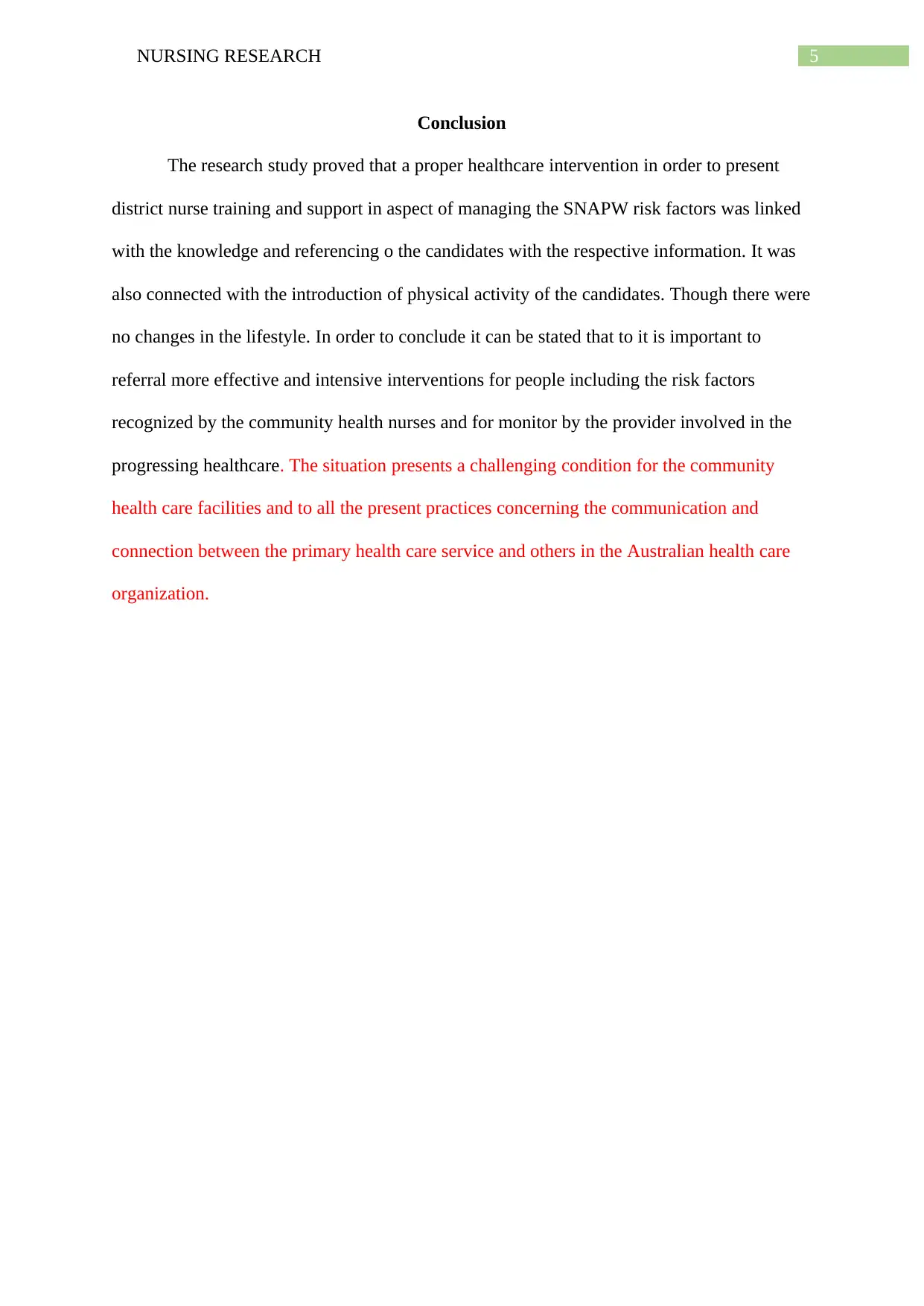
5NURSING RESEARCH
Conclusion
The research study proved that a proper healthcare intervention in order to present
district nurse training and support in aspect of managing the SNAPW risk factors was linked
with the knowledge and referencing o the candidates with the respective information. It was
also connected with the introduction of physical activity of the candidates. Though there were
no changes in the lifestyle. In order to conclude it can be stated that to it is important to
referral more effective and intensive interventions for people including the risk factors
recognized by the community health nurses and for monitor by the provider involved in the
progressing healthcare. The situation presents a challenging condition for the community
health care facilities and to all the present practices concerning the communication and
connection between the primary health care service and others in the Australian health care
organization.
Conclusion
The research study proved that a proper healthcare intervention in order to present
district nurse training and support in aspect of managing the SNAPW risk factors was linked
with the knowledge and referencing o the candidates with the respective information. It was
also connected with the introduction of physical activity of the candidates. Though there were
no changes in the lifestyle. In order to conclude it can be stated that to it is important to
referral more effective and intensive interventions for people including the risk factors
recognized by the community health nurses and for monitor by the provider involved in the
progressing healthcare. The situation presents a challenging condition for the community
health care facilities and to all the present practices concerning the communication and
connection between the primary health care service and others in the Australian health care
organization.
⊘ This is a preview!⊘
Do you want full access?
Subscribe today to unlock all pages.

Trusted by 1+ million students worldwide
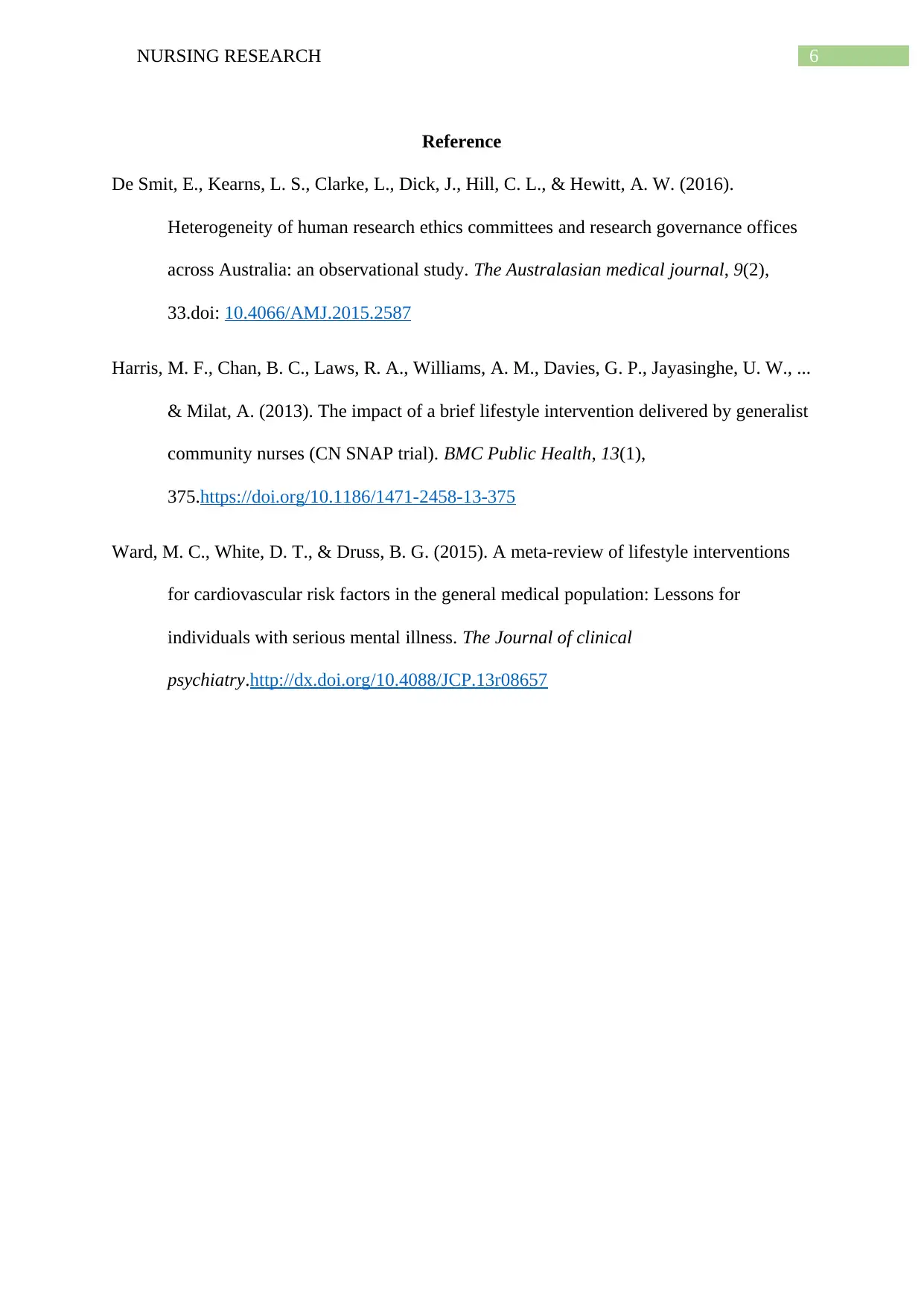
6NURSING RESEARCH
Reference
De Smit, E., Kearns, L. S., Clarke, L., Dick, J., Hill, C. L., & Hewitt, A. W. (2016).
Heterogeneity of human research ethics committees and research governance offices
across Australia: an observational study. The Australasian medical journal, 9(2),
33.doi: 10.4066/AMJ.2015.2587
Harris, M. F., Chan, B. C., Laws, R. A., Williams, A. M., Davies, G. P., Jayasinghe, U. W., ...
& Milat, A. (2013). The impact of a brief lifestyle intervention delivered by generalist
community nurses (CN SNAP trial). BMC Public Health, 13(1),
375.https://doi.org/10.1186/1471-2458-13-375
Ward, M. C., White, D. T., & Druss, B. G. (2015). A meta-review of lifestyle interventions
for cardiovascular risk factors in the general medical population: Lessons for
individuals with serious mental illness. The Journal of clinical
psychiatry.http://dx.doi.org/10.4088/JCP.13r08657
Reference
De Smit, E., Kearns, L. S., Clarke, L., Dick, J., Hill, C. L., & Hewitt, A. W. (2016).
Heterogeneity of human research ethics committees and research governance offices
across Australia: an observational study. The Australasian medical journal, 9(2),
33.doi: 10.4066/AMJ.2015.2587
Harris, M. F., Chan, B. C., Laws, R. A., Williams, A. M., Davies, G. P., Jayasinghe, U. W., ...
& Milat, A. (2013). The impact of a brief lifestyle intervention delivered by generalist
community nurses (CN SNAP trial). BMC Public Health, 13(1),
375.https://doi.org/10.1186/1471-2458-13-375
Ward, M. C., White, D. T., & Druss, B. G. (2015). A meta-review of lifestyle interventions
for cardiovascular risk factors in the general medical population: Lessons for
individuals with serious mental illness. The Journal of clinical
psychiatry.http://dx.doi.org/10.4088/JCP.13r08657
1 out of 7
Related Documents
Your All-in-One AI-Powered Toolkit for Academic Success.
+13062052269
info@desklib.com
Available 24*7 on WhatsApp / Email
![[object Object]](/_next/static/media/star-bottom.7253800d.svg)
Unlock your academic potential
Copyright © 2020–2025 A2Z Services. All Rights Reserved. Developed and managed by ZUCOL.





